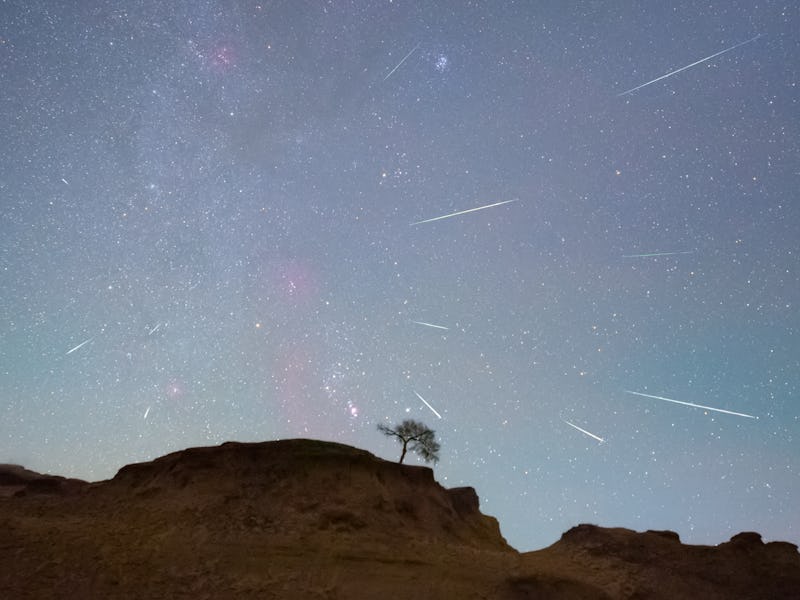Orionid meteor shower: How to watch the most spectacular light show in October
The meteor shower originates from this very familiar comet.

One of the most popular meteor showers of the year is about to kick off on Earth, and it’s coming in fast.
The Orionid meteor shower is back, bringing a brilliant light show to the skies. It takes place every year sometime between early October and early November, with a peak in mid-to-late October.
The annual shower puts on a spectacular light show every time, and here’s everything you need to know on how to watch the Orionids this year.
When is the Orionid meteor shower?
Although the Orionid meteor shower is not the strongest, it is considered to be the most beautiful shower of the year. The meteor shower is also known for its speed — it races through Earth's atmosphere at a pace of 148,000 miles per hour.
The Orionids start trickling down through Earth’s atmosphere in the beginning of October, and last until early November. Most years the shower takes place between October 2 till November 7. The peak of the meteor shower — or the time when it has the most meteors per hour — will take place on October 21.
What time is the Orionids meteor shower?
The Orionids can be viewed any time during the month of October and into the first week of November between the hours of midnight and dawn.
But this meteor shower will hit its peak around October 21, and they are best visible at 2 a.m. local time. You can expect about 20 meteors per hour.
How to see the Orionids meteor shower 2021
The Orionid meteor shower is well known for putting on quite a show.
The Orionids meteor shower may not be the strongest, but they are the fastest.
The shower produces up to 20 meteors an hour if viewed in the total darkness of the night.
However, this year the Orionids happen to peak around the same time as the full Moon so its shooting balls of light will be drowned out by the overpowering light of the Moon in the night sky. But it’s still worth checking out the Orionid meteor shower as they can be viewed from any point in the sky.
What direction should I look to see the Orionid meteor shower?
In order to situate yourself for this nighttime viewing, find the shape of the Orion Constellation. The meteor shower’s radiant point will be near the bright star Betelgeuse, above Orion’s shoulder.
In order to view the meteor shower at its peak, you need to look about 30 degrees away from the constellation. The best time to see it is a few hours before dawn. It’s also best to get away from any sources of light, and find a high vantage point to reduce any sort of light pollution from disrupting your viewing.
You also want to block out any light coming from electronic devices or flashlights screens and allow your eyes to get accustomed to the darkness for around 30 minutes before you look up.
What comet is associated with the Orionids meteor shower
The meteor shower is named after the Orion Constellation as the shower appears to originate from the point in the sky where the constellation is located.
Orionids come from comet 1P/Halley. The comet takes about 76 years to orbit the Sun once.
Although it was last observed in the year 1986, and won’t be returning to the inner Solar System again until the year 2061, Comet Halley remains one of the best known among its icy companions.
When Earth passes though a comet's orbit what happens?
Meteor showers are created from the bits of debris that fall from comets and asteroids. As these rocky bodies of frozen gas, dust, and other material travel toward the Sun, the star's powerful gravitational pull can weaken them, breaking them apart as they draw near.
Many meteors that enter the atmosphere during meteor showers are no bigger than a small pebble, with many being the size of a grain of sand. However, even small particles like this have the right speed to give a good light show as they enter the atmosphere.
How often does the Orionid meteor shower occur?
The Orionids take place every year around the same time. That’s when Earth passes through the debris leftover from Comet Halley in its 365 day orbit. This means that, like most meteor showers, you can expect the light show to return the next year.
When is the next meteor shower in Fall 2021?
The next meteor shower to look out for is the Northern Taurids, which will peak late night on November 11 and last until the next day. It produces only about five meteors per hour. The Geminids will peak on the evening of November 17 to November 18 in the early morning, producing 15 meteors per hour. This all of course pales in comparison to December’s Geminids, the biggest meteor shower of the year.